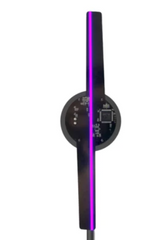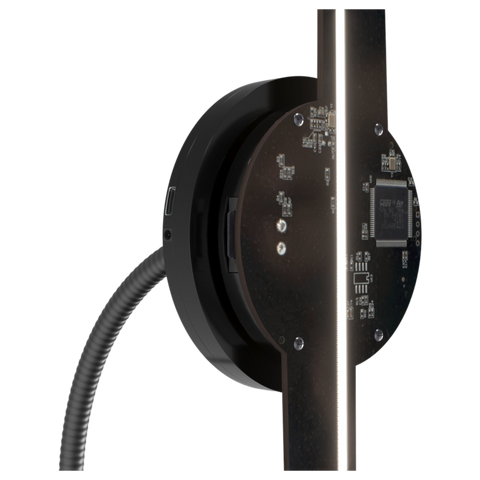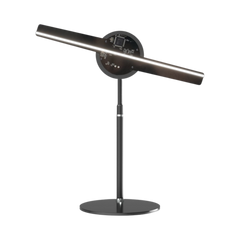Welcome to our detailed blog post on hologram fans! In this article, we will explore the fascinating technology behind hologram fans and how they are able to display captivating images. So, let's dive right in!
What is a Hologram Fan?
A hologram fan, also known as a holographic fan or hologram projector, is a cutting-edge device that creates the illusion of a three-dimensional image or video floating in mid-air. It utilizes a combination of LED lights and a rapidly spinning fan to achieve this mesmerizing effect. Our eyes have a limited ability to retain an image for a fraction of a second. By flashing the LEDs at specific times during each rotation, the fan tricks our eyes into perceiving a continuous image. This image is then combined with the surrounding environment, resulting in a holographic projection that appears to float in mid-air.
How Does It Work?
The hologram fan works by employing a technique called persistence of vision. The fan consists of multiple LED lights arranged in a circular pattern on its blades. When the fan spins at high speed, the LEDs emit light at precise intervals, creating a persistence of vision effect.
Welcome to our detailed blog post on holo fans! In this article, we will explore the fascinating technology behind hologram fans and how they are able to display captivating images. So, let's dive right in!
Displaying Images and Videos
To display images or videos, hologram fans require specially formatted content. These files are typically created using computer software or a specilised app for your phone that converts regular images or videos into a format compatible with the fan's display technology.
Once the content is prepared, it is transferred to the hologram fan's internal memory or loaded from an external storage device. The fan then plays the content in a loop, synchronizing the LED flashes with the rotation speed to create a seamless holographic display.

Core components of a 3d hologram fan?
The core make up of a hologram fan consists of the following components:
1. LED Lights
Hologram fans utilize LED lights to project images. These lights are strategically placed around the fan blades and emit light at different angles. The combination of these lights creates the illusion of a three-dimensional image.
In this blog post, we will delve into the fascinating world of LED lights and how they create mesmerizing effects on a hologram fan. LED lights, or Light Emitting Diodes, are a type of solid-state lighting that have become increasingly popular due to their energy efficiency, long lifespan, and versatility

At a minimum, a hologram fan typically consists of 256 individual LED lights. These LEDs are evenly distributed around the fan's blades to ensure a smooth and seamless hologram effect. Each LED can be controlled independently, allowing for precise control over the displayed images or animations. By manipulating the timing and intensity of the LED lights, the hologram fan can create a wide range of visual effects, from simple shapes to complex animations.
The large number of LEDs on a hologram fan enables the creation of high-resolution holographic images. The more LEDs there are, the finer the details that can be displayed. This is particularly important when displaying intricate designs or text, as it ensures clarity and legibility.
2. Fan Blades
The fan blades of a hologram fan are designed to spin rapidly. As the blades rotate, they create a persistence of vision effect, which allows the human eye to perceive a continuous image. The spinning motion is crucial for creating the illusion of a floating hologram.
3. Image Source and computer chip
A hologram fan requires an image or video source to display the desired content. This can be achieved by connecting the fan to a computer or other media devices. The image or video is then processed and synchronized with the rotation of the fan blades to create the holographic effect. As you can imagine this requires a complex algorithm and advanced computer chip to enable this process.

When you upload an image or video to a hologram fan, the computer chip processes the data and converts it into a format that can be displayed by the fan. It analyzes the image's pixels, color information, and other attributes to generate the necessary instructions for the fan's LED lights.
The computer chip also handles the synchronization of the LED lights with the fan's rotation speed, ensuring that the images appear smooth and coherent. It calculates the precise timing and intensity of each LED light to create the desired visual effect.
4. Control System
To operate a hologram fan, a control system is necessary. This system allows users to adjust settings such as rotation speed, brightness, and image selection. It may include buttons, a remote control, or even smartphone connectivity for convenient operation.

A hologram fan is a fascinating device that combines LED lights, fan blades, an image source, a control system, and a power supply to create the illusion of a three-dimensional holographic image. Understanding the core make up of a hologram fan helps us appreciate the technology behind this innovative display device.
If you're interested in experiencing the magic of hologram fans firsthand, we recommend checking out the Holox product. Holox offers a wide range of high-quality hologram fans that are perfect for both personal and professional use. Visit their website to explore their product lineup and find the perfect hologram fan for you!
In conclusion, hologram fans are an incredible innovation that brings virtual images to life. By leveraging persistence of vision and clever LED manipulation, these devices create stunning holographic displays. If you're looking to add a touch of futuristic technology to your space, a hologram fan is definitely worth considering!




























































